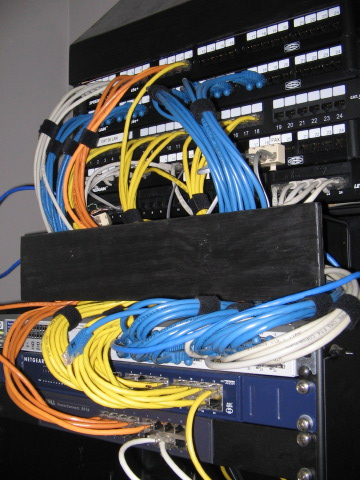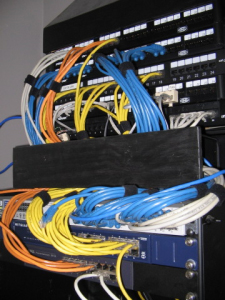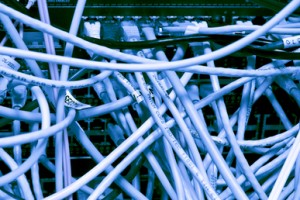


Cable Internet Packages
In today’s fast-paced business environment, high-bandwidth applications are essential for staying competitive. Cable internet has emerged as the preferred choice over DSL, offering faster speeds, greater reliability, and scalable options suitable for businesses of all sizes.

Streamline Your Office Network with Cat6 Wiring and IT Rack Setup by Progressive Office Cabling

Optimizing Your Warehouse with Cat6 AP Wiring: A Guide from Progressive Office Cabling
Why Cat6 AP Wiring is Essential for Warehouses
1. High-Speed Data Transfer
Cat6 cabling is designed to handle high-speed data transmission up to 10 Gbps over short distances, making it ideal for the demands of modern warehouses. Whether you’re managing inventory systems, real-time tracking, or high-resolution video surveillance, Cat6 AP wiring ensures that your network can handle large amounts of data quickly and efficiently. This high-speed capability reduces latency and improves overall system performance.
2. Enhanced Reliability
Warehouse environments often present challenges such as high-density equipment and large physical spaces. Cat6 AP wiring provides superior performance with reduced crosstalk and interference compared to older cabling standards. This reliability ensures that your warehouse network remains stable, minimizing downtime and disruptions that could impact operations. By investing in Cat6, you’re investing in a network infrastructure that supports the demanding conditions of a warehouse.
3. Future-Proofing Your Network
As technology advances, so do the demands on your network infrastructure. Cat6 cabling is designed to support current and emerging technologies, providing a level of future-proofing that older cabling standards cannot. By choosing Cat6 AP wiring, you ensure that your network can accommodate future upgrades and new technologies without requiring a complete overhaul.
Benefits of Cat6 AP Wiring in Warehouse Environments
1. Improved Wireless Coverage
Access points (APs) are crucial for providing wireless connectivity throughout a warehouse. Cat6 AP wiring ensures that these access points are connected to the network with high-speed, reliable connections. This improved connectivity results in better wireless coverage, allowing employees to use mobile devices, barcode scanners, and other wireless tools without experiencing connectivity issues. Enhanced wireless coverage can lead to increased productivity and more efficient operations.
2. Scalability and Flexibility
Warehouses often need to adapt quickly to changing requirements, such as the addition of new equipment or expansion of operations. Cat6 AP wiring offers the flexibility to scale your network as needed. With its high-speed capabilities and reliability, Cat6 cabling can easily support additional access points, devices, or network expansions without compromising performance. This scalability ensures that your network infrastructure can grow with your business.
3. Simplified Maintenance and Troubleshooting
Modern Cat6 cabling systems are designed for easy installation and maintenance. The clear labeling and structured design of Cat6 AP wiring make it straightforward to identify and address any issues that arise. This ease of maintenance can reduce downtime and ensure that your warehouse operations remain uninterrupted. Additionally, structured cabling systems like Cat6 simplify troubleshooting, allowing for quicker resolution of network problems.
Choosing Progressive Office Cabling for Your Cat6 AP Wiring Needs
When it comes to installing or upgrading your warehouse network, Progressive Office Cabling is your trusted partner. Here’s why you should choose us:
- Expertise and Experience: Our team of skilled technicians has extensive experience in designing and installing Cat6 AP wiring solutions tailored to the unique needs of warehouse environments. We understand the complexities of warehouse operations and provide solutions that enhance performance and reliability.
- Quality and Reliability: We use only the highest-quality Cat6 cabling and components to ensure optimal performance and longevity. Our commitment to quality means you receive a network infrastructure that stands up to the demands of your warehouse.
- Customized Solutions: We offer customized wiring solutions that align with your specific requirements and operational needs. Our approach ensures that your network is designed for maximum efficiency and scalability.
Contact Progressive Office Cabling Today
If you’re ready to enhance your warehouse network with Cat6 AP wiring, contact Progressive Office Cabling. Our team is here to provide expert advice, high-quality installations, and ongoing support to ensure your network operates smoothly and efficiently. Call us today or visit our website to schedule a consultation and learn more about how we can help optimize your warehouse operations.
With Progressive Office Cabling, you can trust that your warehouse network will be equipped to handle the demands of today’s technology and prepare for the future. Let us help you build a robust, high-speed network that drives efficiency and productivity in your warehouse.

Is Up-to-Date Structured Cabling Crucial for Your Business?
 If you are busy running a business every day, you probably don’t consider the IT infrastructure of your company very often. However, if you let it become outdated, you will make your enterprise un-competitive and prevent it from achieving its potential.
If you are busy running a business every day, you probably don’t consider the IT infrastructure of your company very often. However, if you let it become outdated, you will make your enterprise un-competitive and prevent it from achieving its potential.
Think of your IT network as the transport system for your data and some of the services your firm provides. Using structured cabling is the best way to ensure its efficiency. This system is advantageous because it allows the connection, movement, and removal of devices without needing new cables every time there is a change.
A structured cabling system that is up-to-date can run optimally in the present and also allow a company to readily expand in the future as its business grows. The following are five advantages of a structured cabling system.
Decreased Maintenance Costs
Replacing old cabling with superior high-quality cabling will ensure better performance and longevity. Structured cabling also makes it much easier to trace and repair problems, resulting in less downtime and monetary losses from maintenance work. The unification of data, voice, and video on a single IT network will also reduce the time needed for maintaining and repairing components.
Ease of Management
The consolidation of cabling under a single system that can handle data in several formats will be much easier to manage than a disorganized system of multiple point-to -point wiring. Structured cable also allows longer cable runs, which help decrease errors and interference affecting data. Cabling will also be easier to remove and install.
Greater Speeds
Slow data transmission hurts the bottom line because time is money. If your company still has obsolete CAT3 cables, upgrade to CAT5e or CAT6 cables to keep up with your competitors. Fiber optic cables will provide even better performance. Upgrading will also allow your organization to more easily expand when more bandwidth is needed.
Less Clutter
A well-organized office projects the desired image for clients and customers. It also helps promotes company pride among employees. Clutter and poor data transmission caused by bundles of disorganized wires and cables will be eliminated by the simplified organization of structured cabling.
Progressive Office Cabling
Founded in 1986, Progressive Office’s success has been a direct result of years of commitment to seeking solutions on behalf of our clients in the Washington, D.C. and New York City areas. Efficiently working together, Progressive Office teams get cabling installed and operating as fast as possible while minimizing disruption and downtime. Call our toll free number (800) 614-4560 today.

8 Network Cabling Mistakes to Avoid – Part 2
 As discussed in Part 1, the improper I can result in poor network performance, maintenance issues, and concealed expenses. Part 2 will discuss four more network cabling errors to avoid. Remember to consult with a cabling company that is experienced and provides excellent service.
As discussed in Part 1, the improper I can result in poor network performance, maintenance issues, and concealed expenses. Part 2 will discuss four more network cabling errors to avoid. Remember to consult with a cabling company that is experienced and provides excellent service.
Mistake No. 5: Ignoring Distance Limitations
The standard distance limitation for UTP cabling with Ethernet at 1 Gbps is 100 meters. For cabling used for 10 Gbps or 40 Gbps, it is important to be aware of the distance limitations of the kind of cabling that will be used. Let’s say your project plans to run 10 Gbps for a maximum of 100 meters over UTP cabling. This will require utilizing at least CAT 6A cabling.
Mistake No. 6: Bypassing Codes
Bypassing local codes may result in endangering first responders. In most facilities, it is prohibited to use PVC-jacketed cabling within air handling spaces. When PVC cabling burns, it produces poisonous fumes that can be hazardous to firefighters and other first responders who must enter the facility during an emergency.
The failure to comply with local codes with respect to low voltage cabling may result in costly fines and perhaps even being ordered to completely remove and reinstall cabling, an expensive exercise. Working with a reputable cabling service company that is knowledgeable regarding local ordinances will avoid future problems.
Mistake No. 7: Neglecting Testing
After cabling is installed, testing should be performed on every cable, using equipment that can verify functionality. The verification of cable lengths and specifications is also important. For certain transmission rates, it must be verified that the cabling is capable of adequately providing support.
Mistake No. 8: Non-Compliance with Standards
Your company’s project should comply with technical standards to ensure the proper functioning of its network. Non-compliance will make noise and interference more likely, leading to inefficiency and poor network performance.
Network cabling standards are used worldwide and are drafted by ISO/IEC, CENELEC and the Telecommunications Industry Association (TIA). TIA (USA) issues the ANSI/TIA-568 standards for telecommunications cabling in commercial facilities.
Progressive Office Cabling
Founded in 1986, Progressive Office’s success has been a direct result of years of commitment to seeking solutions on behalf of our clients in the Washington, D.C. and New York City areas. Efficiently working together, Progressive teams get cabling installed and operating as fast as possible while minimizing disruption and downtime. Call our toll free number (800) 614-4560 today.

8 Network Cabling Mistakes to Avoid – Part 1
 Improperly installed twisted pair cabling can result in poor network performance, maintenance issues, and concealed expenses. The following article discusses eight network cabling errors to avoid. To get the best results for your cabling project, make sure to consult with a company that is experienced and provides excellent service.
Improperly installed twisted pair cabling can result in poor network performance, maintenance issues, and concealed expenses. The following article discusses eight network cabling errors to avoid. To get the best results for your cabling project, make sure to consult with a company that is experienced and provides excellent service.
Mistake No. 1: No Future Planning
If your company is moving to a new office space and new cabling will be required, it would be wise to avoid outdated technology and install equipment that will meet both your current and future needs. Labor costs will likely be the costliest aspect of the project. Although high-quality cable will not be cheap, it will be well worth the investment for your firm’s network requirements the next several years.
Mistake No. 2: Poor Cable Management
Implementing rack-based and ladder rack cable management will certainly raise the outlay for a project. However, sound cable management will ease maintenance and decrease downtime. You should be aware that cabling tasks do not end after installation. Additional cables will probably be needed, and configurations may be revised. Use a standard system for labeling and color coding cables for faster and easier identification. Doing so will speed tasks like repair, reconfiguration, and replacement.
Mistake No. 3: Parallel with Electrical Wiring
Generated by low voltage, the magnetic field conducted by data UTP (unshielded twisted pair) cables is an important feature for the conveyance of data. However, when UTP cables run parallel to electric wiring, there will be a disruption of its magnetic field. This results in garbled and noisy communication. Sometimes transmissions completely fail from point to point. Another negative effect is the extreme slowing of transmission.
Mistake No. 4: Nearby Devices and Fixtures
Noise can be introduced onto data cabling by more than just electrical wires. Fluorescent lighting, motors, and similar items that shed electrical or magnetic interference will wreak havoc on your cabling infrastructure as well. Make sure that in your planning, you leave a data cable pathway that avoids these kinds of hazards.
Part 2 will discuss four more network cabling errors to avoid.
Progressive Office Cabling
Founded in 1986, Progressive Office’s success has been a direct result of years of commitment to seeking solutions on behalf of our clients in the Washington, D.C. and New York City areas. Efficiently working together, Progressive teams get cabling installed and operating as fast as possible while minimizing disruption and downtime. Call our toll free number (800) 614-4560 today.



